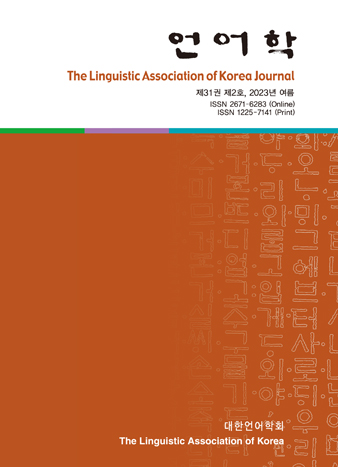대한언어학회 전자저널

31권 2호 (2023년 6월)
- The Role of Alternative Propositions in Uses of English At Least
-
Sang-gu Kang
Pages : 63-79
Abstract
Kang, Sang-gu. (2023). The role of alternative propositions in uses of English at least. The Linguistic Association of Korea Journal, 31(2), 63-79. In the literature, at least has been claimed to be responsible for not only focusing and invoking a pragmatic scale, but also requiring at least two propositional alternatives, one higher and the other lower on the pragmatic scale than the prejacent. This paper investigates the issue of whether both of the alternative propositions are necessary for felicitous uses of at least. In order to verify the presence of the alternative propositions in the context, we examine various discourse data sourced from movies. The findings suggest that the two alternative propositions are not equal in terms of their information status in the concessive use of at least. Specifically, the proposition lower on the pragmatic scale than the prejacent is consistently salient in the contexts of at least, but the proposition higher on the scale is not. The paper accordingly proposes to exclude the requirement of an alternative proposition to the prejacent higher on the pragmatic scale from the semantics of at least.
Keywords
# alternative proposition # pragmatic scale # at least # presupposition # preference
References
- Biezma, M. (2013). Only one at least: refining the role of discourse in building alternatives. University of Pennsylvania Working Papers in Linguistics, 19, 11-19.
- Baranzini, L., & Mari, A. (2019). From epistemic modality to concessivity: alternatives and pragmatic reasoning per absurdum. Journal of Pragmatics, 142, 116-138.
- Chafe, W. (1994). Discourse, consciousness, and time: The flow and displacement of conscious experience in speaking and writing. Chicago, London: University of Chicago Press.
- Geurts, B., & Nouwen, R. (2007). At least et al.: The semantics of scalar modifiers. Language, 83(3), 533-559.
- Geurts, B., & Sandt, R. V. D. (2004). Interpreting focus. Theoretical Linguistics, 30, 1-44.
- Grosz, P. G. (2011). A uniform analysis for concessive at least and optative at least. Proceedings of SALT, 21, 572-591.
- Kay, P. (1992). At least. In Adrienne Lehrer & Eva Feder Kittay (Eds.), Frames, fields, and contrasts (pp. 309-331). Hillsdale, N.J.: L. Erlbaum Associates.
- König, E. (1991). The meaning of focus particles. London, New York: Routledge.
- Nakanishi, K., & Rullmann, H. (2009). Epistemic and concessive interpretation of at least. Paper presented at CLA, Carleton University, 24 May.
- Roberts, C. (1996). Information structure in discourse: Towards an integrated formal theory of pragmatics. OSU Working Papers in Linguistics, 49, 91-136.
- Zeevat, H. (2002). Explaining presupposition triggers. In K. van Deemter & R. Kibble (Eds.), Information sharing: Reference and presupposition in language generation and interpretation (pp. 61-87). Stanford: CSLI.